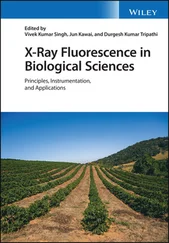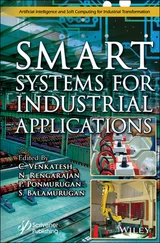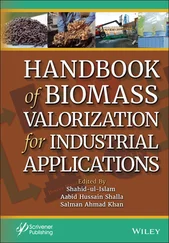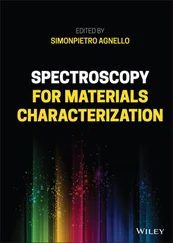In Chapter 3, the various sample preparation procedures typical for X-ray spectrometry are presented and their influence on the precision and trueness of the analyses is discussed. Even though the sample preparation is generally regarded as being very simple for XRF, it is important to carry it out carefully, appropriate to the expectations of the analysis result.
In Chapter 4, the different types of X-ray spectrometers are discussed. On the one hand, the general differences and application characteristics of wavelength-dispersive and energy-dispersive instruments are examined; on the other hand, the different instrument types as well as the instruments currently available on the market are presented.
In Chapter 5, the essential steps for the measurement of a spectrum are reviewed, in particular, the optimum selection of the measurement parameters and the steps for the evaluation of the measured data. The first step is the determination of the intensities of the fluorescence peaks, where different procedures are used for wavelength- and energy-dispersive spectrometers. Then quantification models and factors concerning the consideration of matrix interaction, both in the analysis of homogeneous samples and in the characterization of layers, are presented. Here, a comprehensive and detailed description of the theory of X-ray spectrometry is not required, since a series of detailed papers are available (see, for example, Hahn-Weinheimer et al. 2012; Jenkins et al. 1981; Lachance and Claisse 1994; Mantler 2006) and only very few new ideas have been added in the last few years. In this chapter, further possibilities for the evaluation of spectra are presented, in which the individual spectral components are not considered separately, but the spectrum as a whole is evaluated by means of chemometric methods.
Chapter 6is devoted to the discussion of the classification, determination, and evaluation of errors. The achievable analytical precision of XRF is determined by the errors. In addition to the traditional treatment of errors with the Gaussian error model, the principle of measurement uncertainty is also discussed. This chapter is intended to qualify the expectations of an analytical result.
In Chapters 7and 8, a brief comparison is made with other element analysis methods, in particular atomic absorption and emission spectrometry as well as mass spectrometry. The fundamentals of radiation protection when dealing with X-ray radiation, in particular when carrying out X-ray analysis experiments, are compiled as well.
Based on these fundamentals, various applications of XRF, which have been used already over a long time period or were introduced recently, are presented and discussed. The presentation here is carried out according to the different sample qualities or according to the analytical question.
Typical XRF applications are discussed first. Chapter 9discusses the analysis of homogeneous solid samples, such as various metallic materials, glasses, or plastics. Chapter 10describes the investigation of powdered samples, such as geological samples, soil, building materials, slags, and dusts.
In Chapter 11, the different possibilities for analyzing liquids are presented, either by direct analysis or, for example, by different enrichment procedures to answer specific analytical questions. Applications with total reflection XRF (TXRF) are dealt with in Chapter 12. Here, in addition to ultra-trace analyses of liquids the analysis of very small sample quantities is the focus.
Descriptions of the analysis of nonhomogeneous materials cover a wide range of analytical questions. This concerns inhomogeneities normal to the sample surface, i.e. the characterization of layered materials ( Chapter 14) along with their different applications, as well as inhomogeneities in the sample plane and the analysis of irregularly shaped samples ( Chapter 15). In this case, only small sample areas are to be analyzed, which means a point analysis has to be carried out. This is important when identifying particles or inclusions as also when analyzing inhomogeneous materials.
Handheld instruments are increasingly being used for element analysis. Based on this fact, the applications that up to now have been typical for this instrument technology are presented in Section 15.4. It was possible to increase the efficiency of this type of instruments significantly in recent years due to the miniaturization of all hardware assemblies. In this way, their range of measurement applications could be expanded continuously. An important factor for that expansion is the possibility for “on-site” analysis, i.e. materials for analysis are no longer required to be taken to a laboratory. However, the quality of the analyses is not as high, mainly because of a very simplified or even completely missing sample preparation, undefined sample geometry, or contamination in the measuring environment.
A further important field of application of spatially resolved analysis, the determination of element distributions, is dealt with in Chapter 16. This method allows not only the analysis of small areas on structured materials, but also the investigation of their element distributions and therefore their more detailed characterization. Presentation of the examples for the distribution analysis is carried out according to the different analytical tasks. For example, the analysis of geological samples and of electronic assemblies as well as homogeneity tests of reference samples is presented.
A specific problem is the analysis of archeological objects, because they cannot be modified by preparation due to their uniqueness. Examples for such analytical tasks are discussed in Section 16.5.
In Chapter 17, special applications of the XRF analysis are described. This implies the high-throughput analysis (HTS) for the characterization of small sample quantities, chemometric spectral evaluation with the resulting possibilities for material characterization, as well as speciation analysis.
Chapter 18presents the requirements and conditions for the use of the XRF in process analysis, with particular attention to the automation of sample preparation. Requirements and possibilities of automated analyses are given, but the associated problems are pointed out as well.
Finally, in a brief discussion in Chapter 19the assurance of the quality of analyses by means of a corresponding quality management system in test laboratories and also the requirements for the validation of test methods are mentioned.
All these applications are intended to demonstrate the wide range of possible measurement applications of XRF as well as the analytical performance that can be achieved.
At the end of the book, in Appendix Anumerical data required for X-ray spectrometry is compiled in a comprehensive set of tables, and in Appendix Bimportant references with information on instrument manufacturers, basic literature for the field of XRF spectrometry, important websites, as well as magazines, standards, and laws that help readers quickly find the right information and contacts for solving their analytical tasks can be found.
2 Principles of X-ray Spectrometry
2.1 Analytical Performance
X-ray analysis has been established as an important method for element analysis. Already since Moseley's discovery in 1913 that the energies of the X-ray lines of individual elements differ from each other and depend on the square of the atomic number of the emitting atoms, preconditions for using this method for element analyses were given. However, it took several years until the first usable equipment for routine analyses was available. In the 1930s the first laboratory instruments were available, but they were not yet suited for routine analyses.
To this purpose, various instrumental prerequisites had to be developed, such as an effective excitation source with sufficient intensity and high stability, the supply of dispersive elements, i.e. crystals with high reflectivity and sufficient size, and then also synthetic multilayers with larger d-spacings, detectors with sufficient counting capacity, instruments that allow for simple and safe operation, in particular for sample positioning, and later also for radiation protection, possibilities for measurement in vacuum, as well as the effective recording of the measurement data and their evaluation. The first applications focused on the identification of the elements present in a sample, i.e. a purely qualitative analysis. In this way, some elements could even be discovered, such as hafnium in 1923 (Coster, v.Hevesy), rhenium in 1925 (Tacke 1925), and technetium in 1947 (Perrier and Segrè 1947).
Читать дальше












